Semester 2, 2017: HLSC122 Assessment 3 - Cognitive Enhancers Report
VerifiedAdded on 2020/05/11
|11
|2601
|57
Report
AI Summary
This report critically evaluates two research studies examining the use of cognitive enhancers, such as prescription stimulants, among university students. The studies, by Hildt et al. (2014) and Munro et al. (2016), explore the prevalence of non-medical prescription stimulant use (NMUPS), its relationship to executive functioning and academic outcomes, and the underlying motivations for use. The report analyzes the methodologies, findings, strengths, and weaknesses of each study, focusing on factors influencing NMUPS, including cognitive deficits, academic pressures, and the potential for adverse health outcomes. The analysis also discusses barriers to implementing evidence-based practice and assesses how closely the studies align with the PICO framework. The conclusion highlights the lack of conclusive evidence supporting the benefits of cognitive enhancers for academic performance and emphasizes the risks associated with their non-medical use, urging students to avoid illicit utilization. References to key literature are also provided.
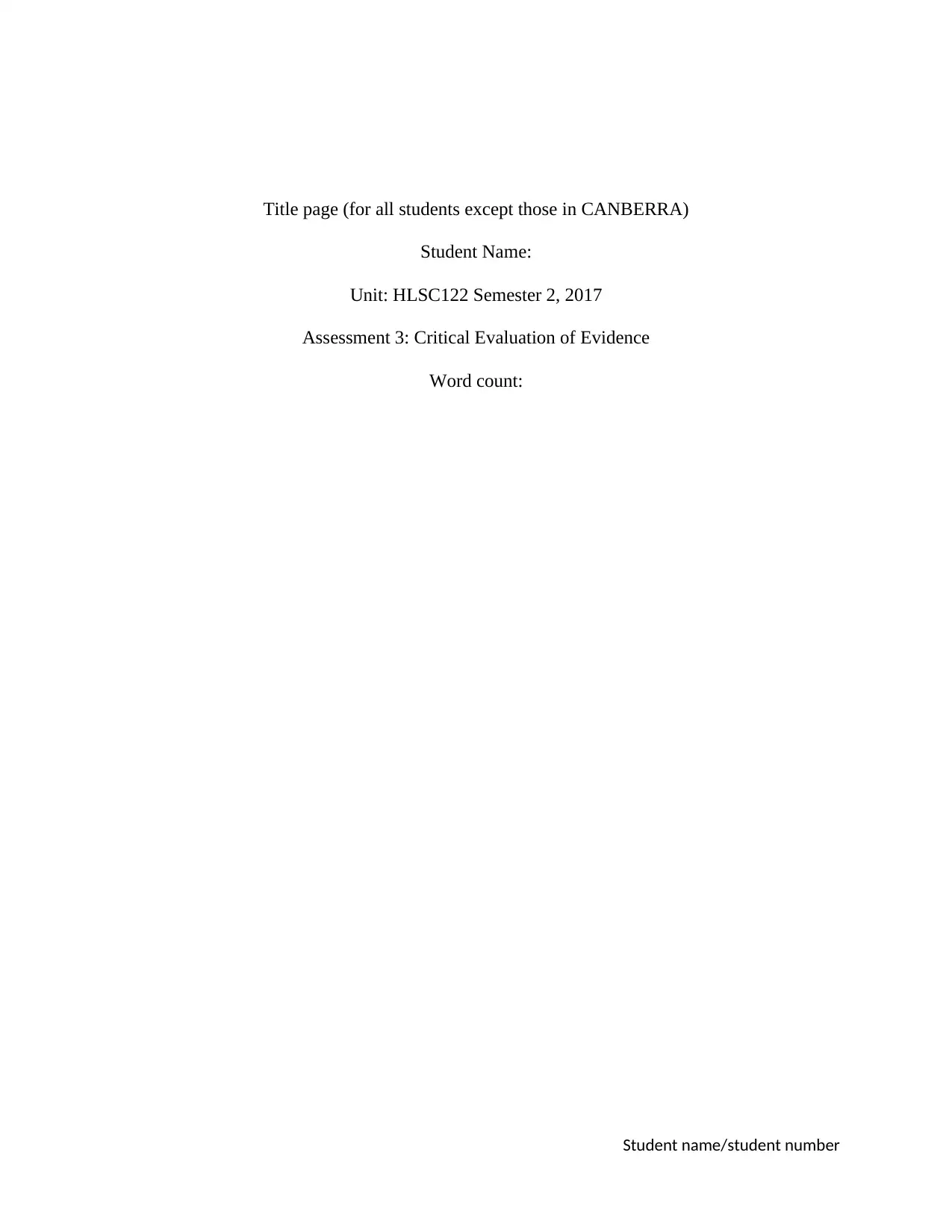
Title page (for all students except those in CANBERRA)
Student Name:
Unit: HLSC122 Semester 2, 2017
Assessment 3: Critical Evaluation of Evidence
Word count:
Student name/student number
Student Name:
Unit: HLSC122 Semester 2, 2017
Assessment 3: Critical Evaluation of Evidence
Word count:
Student name/student number
Paraphrase This Document
Need a fresh take? Get an instant paraphrase of this document with our AI Paraphraser
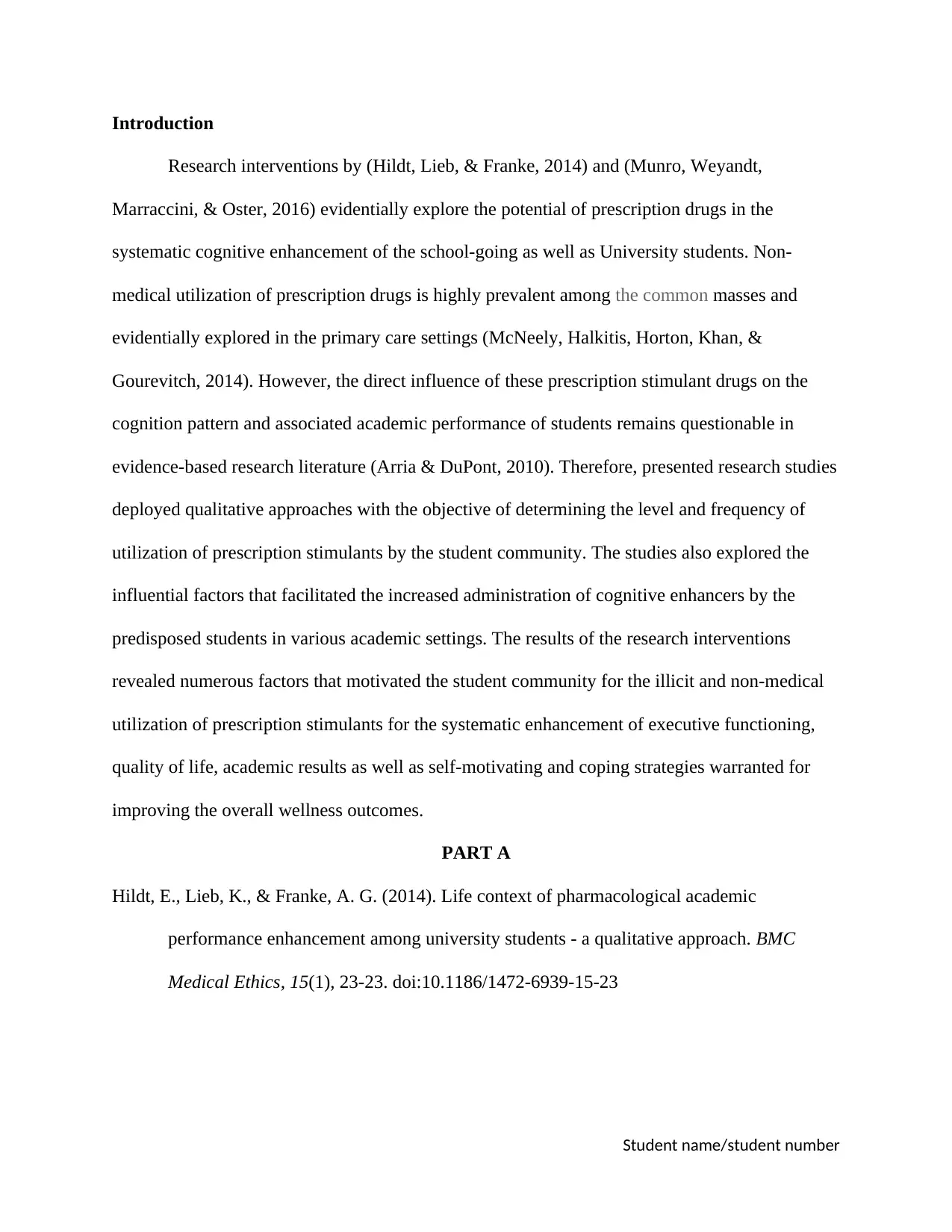
Introduction
Research interventions by (Hildt, Lieb, & Franke, 2014) and (Munro, Weyandt,
Marraccini, & Oster, 2016) evidentially explore the potential of prescription drugs in the
systematic cognitive enhancement of the school-going as well as University students. Non-
medical utilization of prescription drugs is highly prevalent among the common masses and
evidentially explored in the primary care settings (McNeely, Halkitis, Horton, Khan, &
Gourevitch, 2014). However, the direct influence of these prescription stimulant drugs on the
cognition pattern and associated academic performance of students remains questionable in
evidence-based research literature (Arria & DuPont, 2010). Therefore, presented research studies
deployed qualitative approaches with the objective of determining the level and frequency of
utilization of prescription stimulants by the student community. The studies also explored the
influential factors that facilitated the increased administration of cognitive enhancers by the
predisposed students in various academic settings. The results of the research interventions
revealed numerous factors that motivated the student community for the illicit and non-medical
utilization of prescription stimulants for the systematic enhancement of executive functioning,
quality of life, academic results as well as self-motivating and coping strategies warranted for
improving the overall wellness outcomes.
PART A
Hildt, E., Lieb, K., & Franke, A. G. (2014). Life context of pharmacological academic
performance enhancement among university students - a qualitative approach. BMC
Medical Ethics, 15(1), 23-23. doi:10.1186/1472-6939-15-23
Student name/student number
Research interventions by (Hildt, Lieb, & Franke, 2014) and (Munro, Weyandt,
Marraccini, & Oster, 2016) evidentially explore the potential of prescription drugs in the
systematic cognitive enhancement of the school-going as well as University students. Non-
medical utilization of prescription drugs is highly prevalent among the common masses and
evidentially explored in the primary care settings (McNeely, Halkitis, Horton, Khan, &
Gourevitch, 2014). However, the direct influence of these prescription stimulant drugs on the
cognition pattern and associated academic performance of students remains questionable in
evidence-based research literature (Arria & DuPont, 2010). Therefore, presented research studies
deployed qualitative approaches with the objective of determining the level and frequency of
utilization of prescription stimulants by the student community. The studies also explored the
influential factors that facilitated the increased administration of cognitive enhancers by the
predisposed students in various academic settings. The results of the research interventions
revealed numerous factors that motivated the student community for the illicit and non-medical
utilization of prescription stimulants for the systematic enhancement of executive functioning,
quality of life, academic results as well as self-motivating and coping strategies warranted for
improving the overall wellness outcomes.
PART A
Hildt, E., Lieb, K., & Franke, A. G. (2014). Life context of pharmacological academic
performance enhancement among university students - a qualitative approach. BMC
Medical Ethics, 15(1), 23-23. doi:10.1186/1472-6939-15-23
Student name/student number
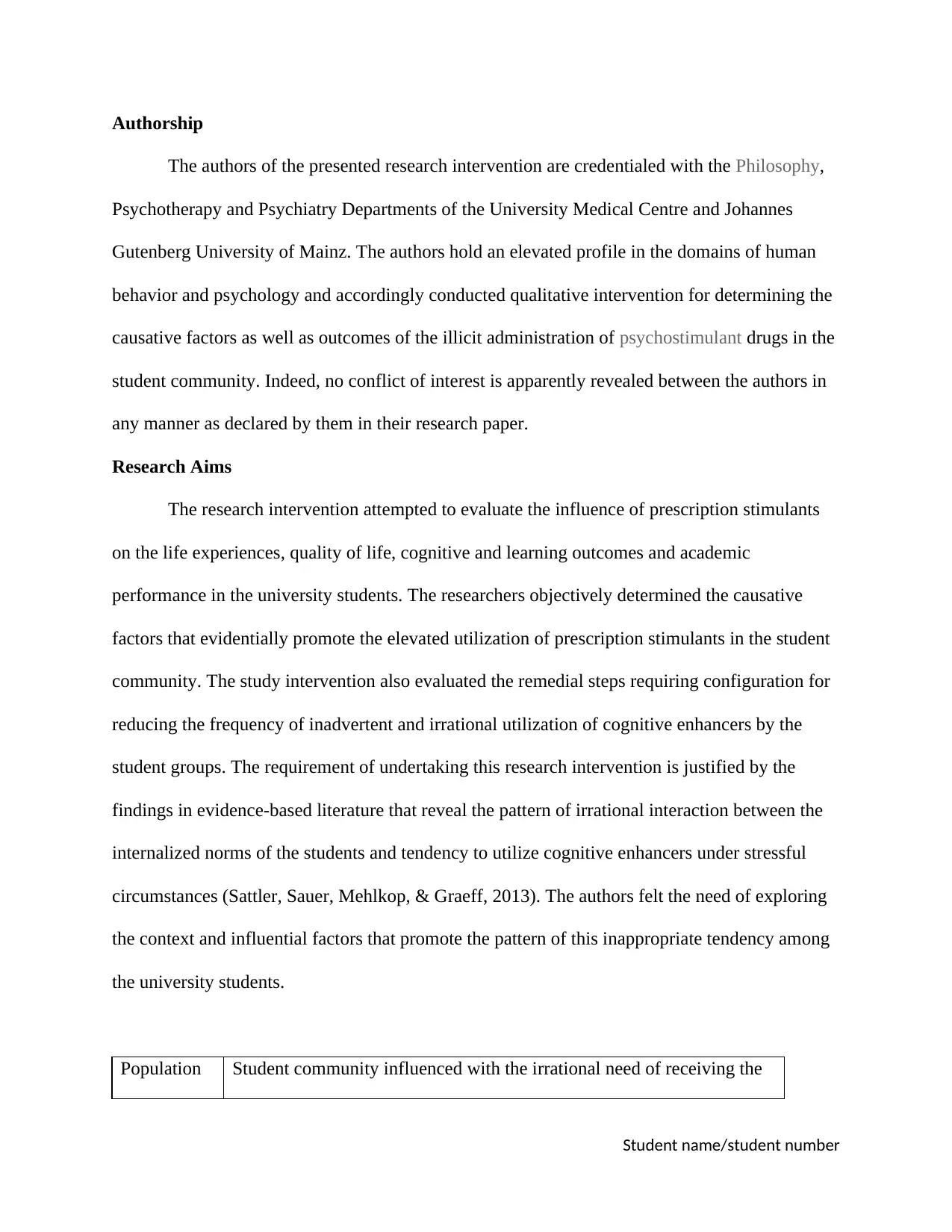
Authorship
The authors of the presented research intervention are credentialed with the Philosophy,
Psychotherapy and Psychiatry Departments of the University Medical Centre and Johannes
Gutenberg University of Mainz. The authors hold an elevated profile in the domains of human
behavior and psychology and accordingly conducted qualitative intervention for determining the
causative factors as well as outcomes of the illicit administration of psychostimulant drugs in the
student community. Indeed, no conflict of interest is apparently revealed between the authors in
any manner as declared by them in their research paper.
Research Aims
The research intervention attempted to evaluate the influence of prescription stimulants
on the life experiences, quality of life, cognitive and learning outcomes and academic
performance in the university students. The researchers objectively determined the causative
factors that evidentially promote the elevated utilization of prescription stimulants in the student
community. The study intervention also evaluated the remedial steps requiring configuration for
reducing the frequency of inadvertent and irrational utilization of cognitive enhancers by the
student groups. The requirement of undertaking this research intervention is justified by the
findings in evidence-based literature that reveal the pattern of irrational interaction between the
internalized norms of the students and tendency to utilize cognitive enhancers under stressful
circumstances (Sattler, Sauer, Mehlkop, & Graeff, 2013). The authors felt the need of exploring
the context and influential factors that promote the pattern of this inappropriate tendency among
the university students.
Population Student community influenced with the irrational need of receiving the
Student name/student number
The authors of the presented research intervention are credentialed with the Philosophy,
Psychotherapy and Psychiatry Departments of the University Medical Centre and Johannes
Gutenberg University of Mainz. The authors hold an elevated profile in the domains of human
behavior and psychology and accordingly conducted qualitative intervention for determining the
causative factors as well as outcomes of the illicit administration of psychostimulant drugs in the
student community. Indeed, no conflict of interest is apparently revealed between the authors in
any manner as declared by them in their research paper.
Research Aims
The research intervention attempted to evaluate the influence of prescription stimulants
on the life experiences, quality of life, cognitive and learning outcomes and academic
performance in the university students. The researchers objectively determined the causative
factors that evidentially promote the elevated utilization of prescription stimulants in the student
community. The study intervention also evaluated the remedial steps requiring configuration for
reducing the frequency of inadvertent and irrational utilization of cognitive enhancers by the
student groups. The requirement of undertaking this research intervention is justified by the
findings in evidence-based literature that reveal the pattern of irrational interaction between the
internalized norms of the students and tendency to utilize cognitive enhancers under stressful
circumstances (Sattler, Sauer, Mehlkop, & Graeff, 2013). The authors felt the need of exploring
the context and influential factors that promote the pattern of this inappropriate tendency among
the university students.
Population Student community influenced with the irrational need of receiving the
Student name/student number
⊘ This is a preview!⊘
Do you want full access?
Subscribe today to unlock all pages.

Trusted by 1+ million students worldwide
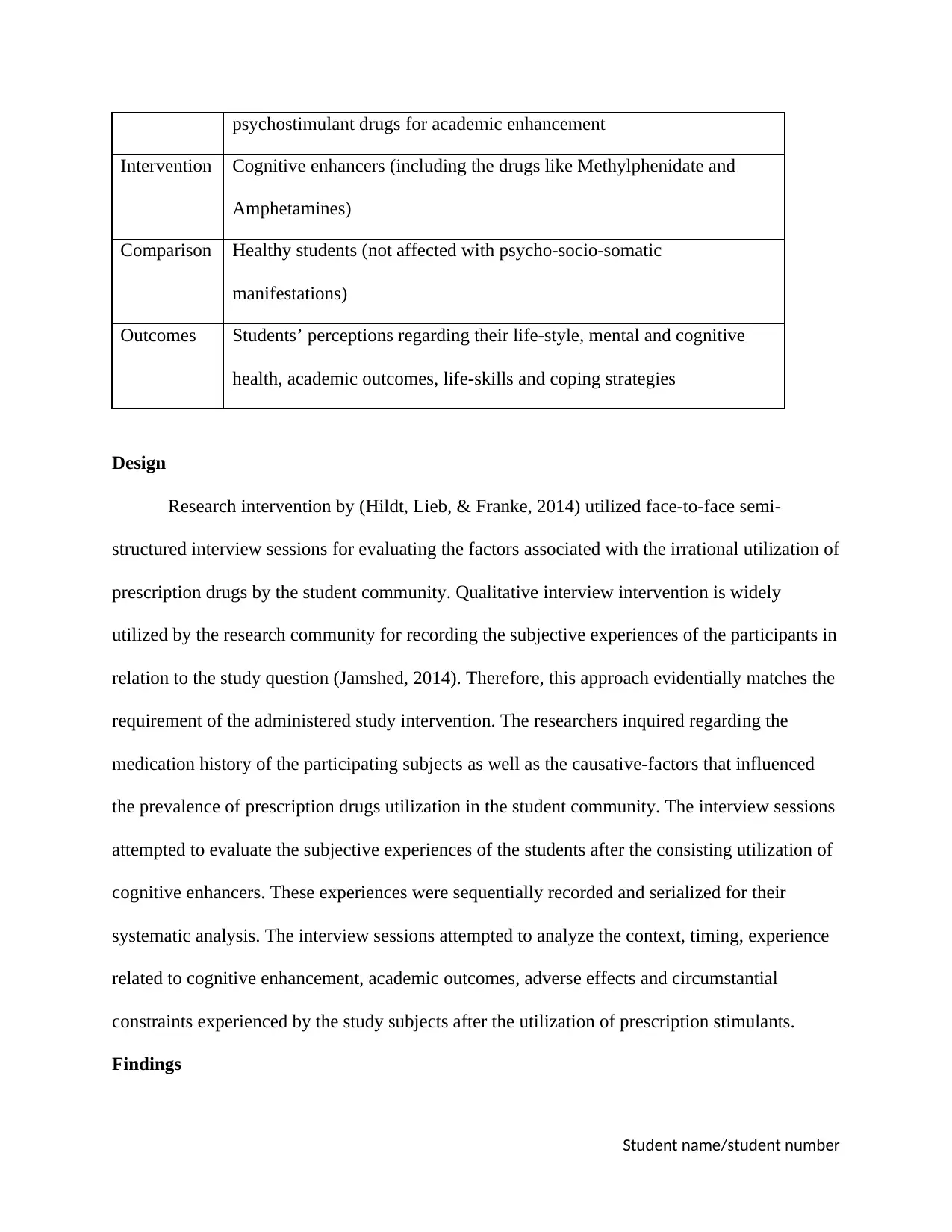
psychostimulant drugs for academic enhancement
Intervention Cognitive enhancers (including the drugs like Methylphenidate and
Amphetamines)
Comparison Healthy students (not affected with psycho-socio-somatic
manifestations)
Outcomes Students’ perceptions regarding their life-style, mental and cognitive
health, academic outcomes, life-skills and coping strategies
Design
Research intervention by (Hildt, Lieb, & Franke, 2014) utilized face-to-face semi-
structured interview sessions for evaluating the factors associated with the irrational utilization of
prescription drugs by the student community. Qualitative interview intervention is widely
utilized by the research community for recording the subjective experiences of the participants in
relation to the study question (Jamshed, 2014). Therefore, this approach evidentially matches the
requirement of the administered study intervention. The researchers inquired regarding the
medication history of the participating subjects as well as the causative-factors that influenced
the prevalence of prescription drugs utilization in the student community. The interview sessions
attempted to evaluate the subjective experiences of the students after the consisting utilization of
cognitive enhancers. These experiences were sequentially recorded and serialized for their
systematic analysis. The interview sessions attempted to analyze the context, timing, experience
related to cognitive enhancement, academic outcomes, adverse effects and circumstantial
constraints experienced by the study subjects after the utilization of prescription stimulants.
Findings
Student name/student number
Intervention Cognitive enhancers (including the drugs like Methylphenidate and
Amphetamines)
Comparison Healthy students (not affected with psycho-socio-somatic
manifestations)
Outcomes Students’ perceptions regarding their life-style, mental and cognitive
health, academic outcomes, life-skills and coping strategies
Design
Research intervention by (Hildt, Lieb, & Franke, 2014) utilized face-to-face semi-
structured interview sessions for evaluating the factors associated with the irrational utilization of
prescription drugs by the student community. Qualitative interview intervention is widely
utilized by the research community for recording the subjective experiences of the participants in
relation to the study question (Jamshed, 2014). Therefore, this approach evidentially matches the
requirement of the administered study intervention. The researchers inquired regarding the
medication history of the participating subjects as well as the causative-factors that influenced
the prevalence of prescription drugs utilization in the student community. The interview sessions
attempted to evaluate the subjective experiences of the students after the consisting utilization of
cognitive enhancers. These experiences were sequentially recorded and serialized for their
systematic analysis. The interview sessions attempted to analyze the context, timing, experience
related to cognitive enhancement, academic outcomes, adverse effects and circumstantial
constraints experienced by the study subjects after the utilization of prescription stimulants.
Findings
Student name/student number
Paraphrase This Document
Need a fresh take? Get an instant paraphrase of this document with our AI Paraphraser
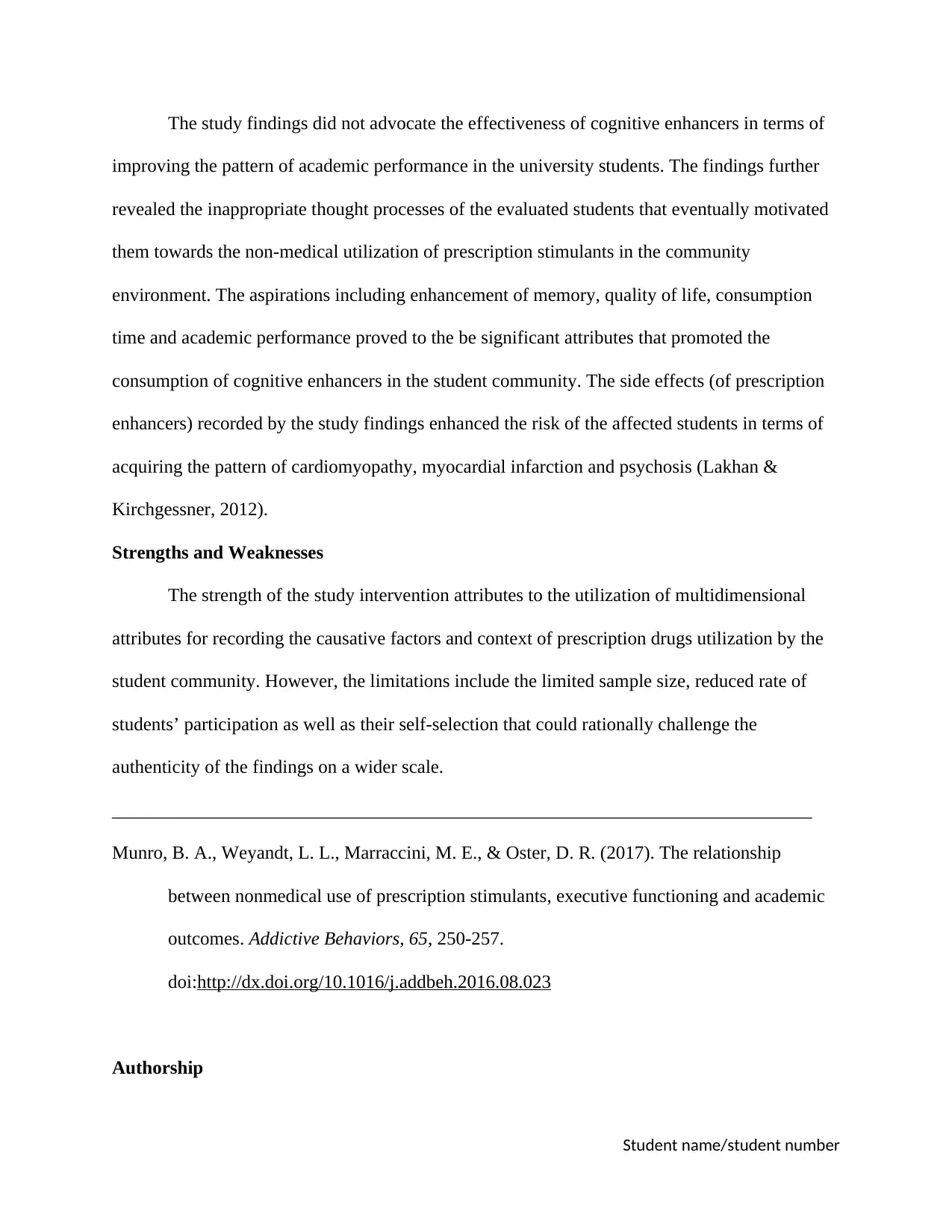
The study findings did not advocate the effectiveness of cognitive enhancers in terms of
improving the pattern of academic performance in the university students. The findings further
revealed the inappropriate thought processes of the evaluated students that eventually motivated
them towards the non-medical utilization of prescription stimulants in the community
environment. The aspirations including enhancement of memory, quality of life, consumption
time and academic performance proved to the be significant attributes that promoted the
consumption of cognitive enhancers in the student community. The side effects (of prescription
enhancers) recorded by the study findings enhanced the risk of the affected students in terms of
acquiring the pattern of cardiomyopathy, myocardial infarction and psychosis (Lakhan &
Kirchgessner, 2012).
Strengths and Weaknesses
The strength of the study intervention attributes to the utilization of multidimensional
attributes for recording the causative factors and context of prescription drugs utilization by the
student community. However, the limitations include the limited sample size, reduced rate of
students’ participation as well as their self-selection that could rationally challenge the
authenticity of the findings on a wider scale.
___________________________________________________________________________
Munro, B. A., Weyandt, L. L., Marraccini, M. E., & Oster, D. R. (2017). The relationship
between nonmedical use of prescription stimulants, executive functioning and academic
outcomes. Addictive Behaviors, 65, 250-257.
doi:http://dx.doi.org/10.1016/j.addbeh.2016.08.023
Authorship
Student name/student number
improving the pattern of academic performance in the university students. The findings further
revealed the inappropriate thought processes of the evaluated students that eventually motivated
them towards the non-medical utilization of prescription stimulants in the community
environment. The aspirations including enhancement of memory, quality of life, consumption
time and academic performance proved to the be significant attributes that promoted the
consumption of cognitive enhancers in the student community. The side effects (of prescription
enhancers) recorded by the study findings enhanced the risk of the affected students in terms of
acquiring the pattern of cardiomyopathy, myocardial infarction and psychosis (Lakhan &
Kirchgessner, 2012).
Strengths and Weaknesses
The strength of the study intervention attributes to the utilization of multidimensional
attributes for recording the causative factors and context of prescription drugs utilization by the
student community. However, the limitations include the limited sample size, reduced rate of
students’ participation as well as their self-selection that could rationally challenge the
authenticity of the findings on a wider scale.
___________________________________________________________________________
Munro, B. A., Weyandt, L. L., Marraccini, M. E., & Oster, D. R. (2017). The relationship
between nonmedical use of prescription stimulants, executive functioning and academic
outcomes. Addictive Behaviors, 65, 250-257.
doi:http://dx.doi.org/10.1016/j.addbeh.2016.08.023
Authorship
Student name/student number
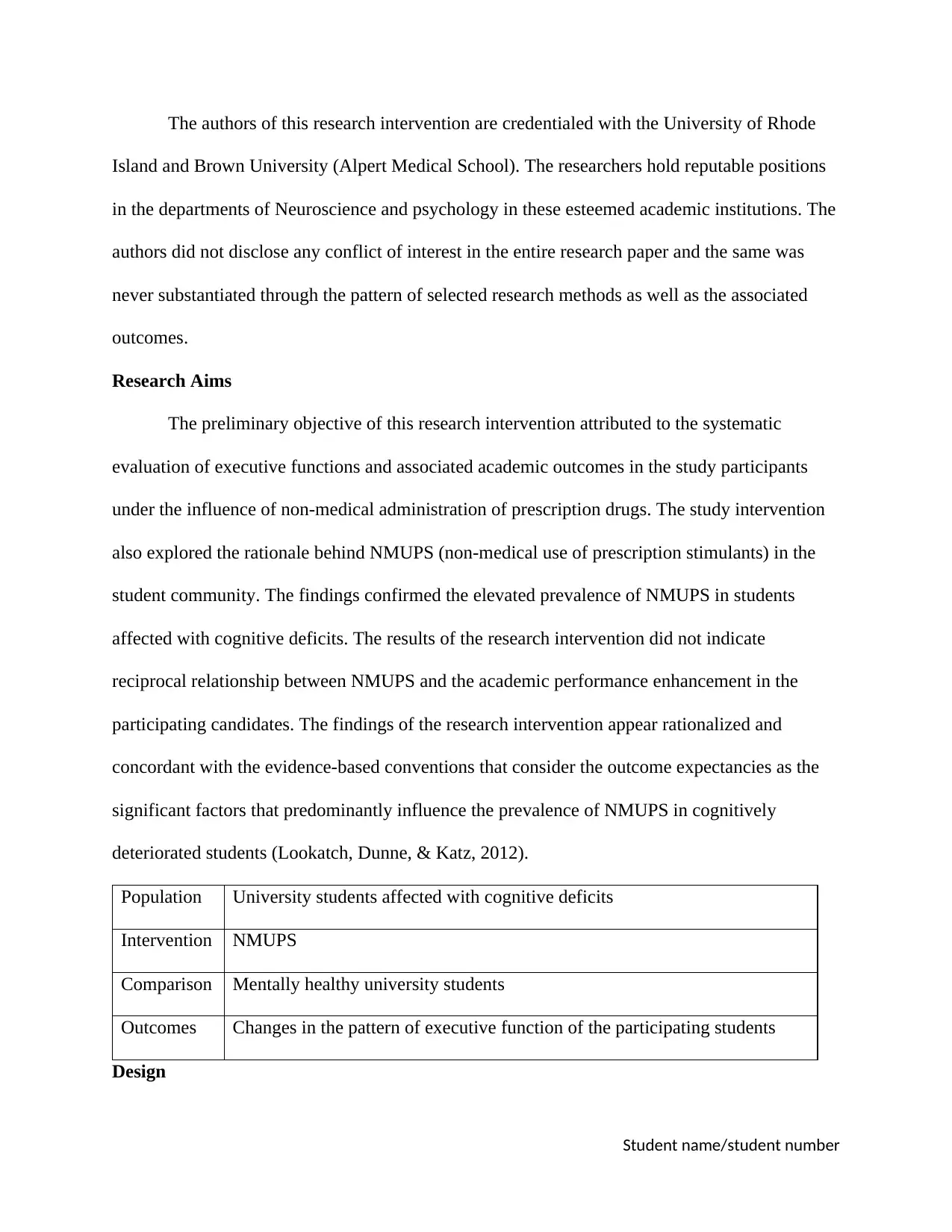
The authors of this research intervention are credentialed with the University of Rhode
Island and Brown University (Alpert Medical School). The researchers hold reputable positions
in the departments of Neuroscience and psychology in these esteemed academic institutions. The
authors did not disclose any conflict of interest in the entire research paper and the same was
never substantiated through the pattern of selected research methods as well as the associated
outcomes.
Research Aims
The preliminary objective of this research intervention attributed to the systematic
evaluation of executive functions and associated academic outcomes in the study participants
under the influence of non-medical administration of prescription drugs. The study intervention
also explored the rationale behind NMUPS (non-medical use of prescription stimulants) in the
student community. The findings confirmed the elevated prevalence of NMUPS in students
affected with cognitive deficits. The results of the research intervention did not indicate
reciprocal relationship between NMUPS and the academic performance enhancement in the
participating candidates. The findings of the research intervention appear rationalized and
concordant with the evidence-based conventions that consider the outcome expectancies as the
significant factors that predominantly influence the prevalence of NMUPS in cognitively
deteriorated students (Lookatch, Dunne, & Katz, 2012).
Population University students affected with cognitive deficits
Intervention NMUPS
Comparison Mentally healthy university students
Outcomes Changes in the pattern of executive function of the participating students
Design
Student name/student number
Island and Brown University (Alpert Medical School). The researchers hold reputable positions
in the departments of Neuroscience and psychology in these esteemed academic institutions. The
authors did not disclose any conflict of interest in the entire research paper and the same was
never substantiated through the pattern of selected research methods as well as the associated
outcomes.
Research Aims
The preliminary objective of this research intervention attributed to the systematic
evaluation of executive functions and associated academic outcomes in the study participants
under the influence of non-medical administration of prescription drugs. The study intervention
also explored the rationale behind NMUPS (non-medical use of prescription stimulants) in the
student community. The findings confirmed the elevated prevalence of NMUPS in students
affected with cognitive deficits. The results of the research intervention did not indicate
reciprocal relationship between NMUPS and the academic performance enhancement in the
participating candidates. The findings of the research intervention appear rationalized and
concordant with the evidence-based conventions that consider the outcome expectancies as the
significant factors that predominantly influence the prevalence of NMUPS in cognitively
deteriorated students (Lookatch, Dunne, & Katz, 2012).
Population University students affected with cognitive deficits
Intervention NMUPS
Comparison Mentally healthy university students
Outcomes Changes in the pattern of executive function of the participating students
Design
Student name/student number
⊘ This is a preview!⊘
Do you want full access?
Subscribe today to unlock all pages.

Trusted by 1+ million students worldwide
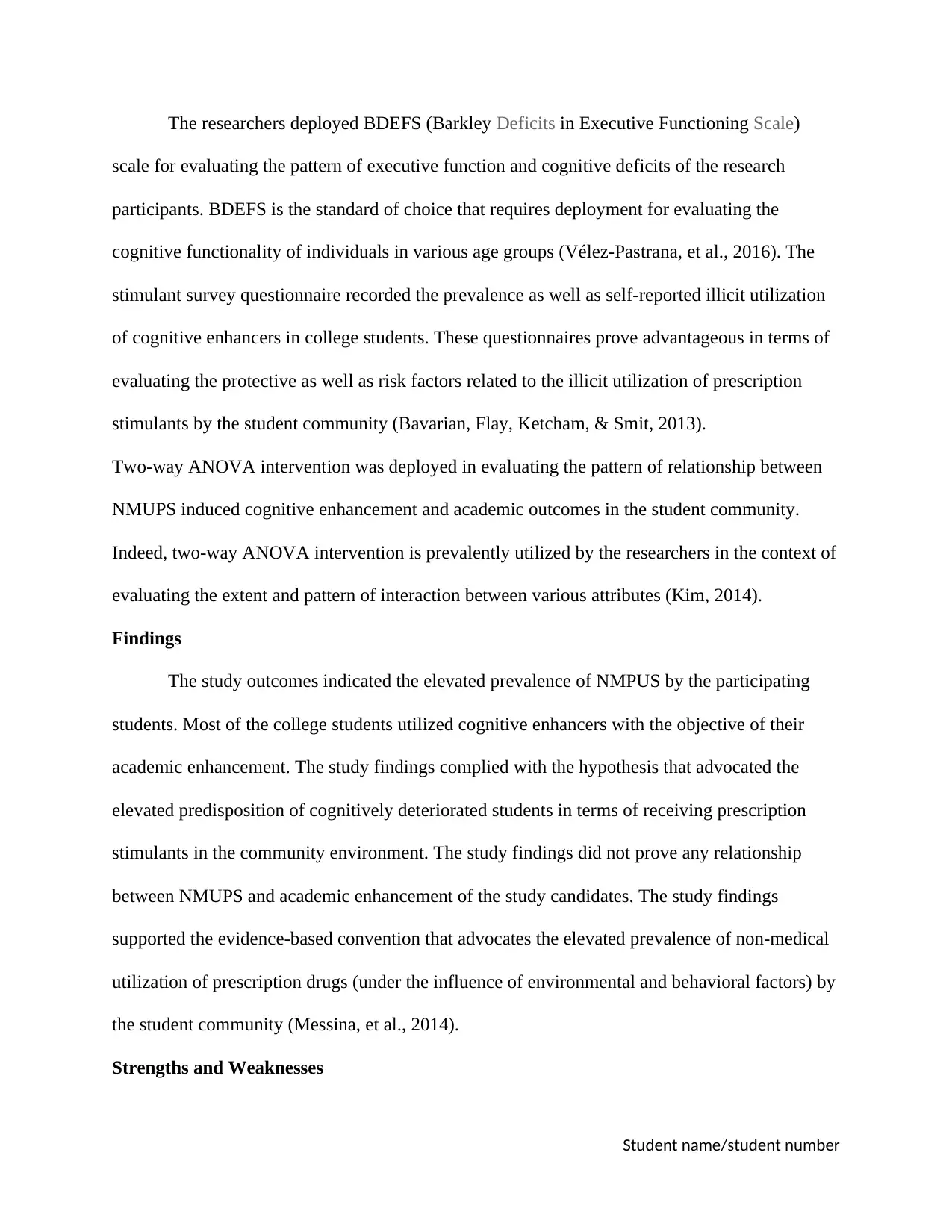
The researchers deployed BDEFS (Barkley Deficits in Executive Functioning Scale)
scale for evaluating the pattern of executive function and cognitive deficits of the research
participants. BDEFS is the standard of choice that requires deployment for evaluating the
cognitive functionality of individuals in various age groups (Vélez-Pastrana, et al., 2016). The
stimulant survey questionnaire recorded the prevalence as well as self-reported illicit utilization
of cognitive enhancers in college students. These questionnaires prove advantageous in terms of
evaluating the protective as well as risk factors related to the illicit utilization of prescription
stimulants by the student community (Bavarian, Flay, Ketcham, & Smit, 2013).
Two-way ANOVA intervention was deployed in evaluating the pattern of relationship between
NMUPS induced cognitive enhancement and academic outcomes in the student community.
Indeed, two-way ANOVA intervention is prevalently utilized by the researchers in the context of
evaluating the extent and pattern of interaction between various attributes (Kim, 2014).
Findings
The study outcomes indicated the elevated prevalence of NMPUS by the participating
students. Most of the college students utilized cognitive enhancers with the objective of their
academic enhancement. The study findings complied with the hypothesis that advocated the
elevated predisposition of cognitively deteriorated students in terms of receiving prescription
stimulants in the community environment. The study findings did not prove any relationship
between NMUPS and academic enhancement of the study candidates. The study findings
supported the evidence-based convention that advocates the elevated prevalence of non-medical
utilization of prescription drugs (under the influence of environmental and behavioral factors) by
the student community (Messina, et al., 2014).
Strengths and Weaknesses
Student name/student number
scale for evaluating the pattern of executive function and cognitive deficits of the research
participants. BDEFS is the standard of choice that requires deployment for evaluating the
cognitive functionality of individuals in various age groups (Vélez-Pastrana, et al., 2016). The
stimulant survey questionnaire recorded the prevalence as well as self-reported illicit utilization
of cognitive enhancers in college students. These questionnaires prove advantageous in terms of
evaluating the protective as well as risk factors related to the illicit utilization of prescription
stimulants by the student community (Bavarian, Flay, Ketcham, & Smit, 2013).
Two-way ANOVA intervention was deployed in evaluating the pattern of relationship between
NMUPS induced cognitive enhancement and academic outcomes in the student community.
Indeed, two-way ANOVA intervention is prevalently utilized by the researchers in the context of
evaluating the extent and pattern of interaction between various attributes (Kim, 2014).
Findings
The study outcomes indicated the elevated prevalence of NMPUS by the participating
students. Most of the college students utilized cognitive enhancers with the objective of their
academic enhancement. The study findings complied with the hypothesis that advocated the
elevated predisposition of cognitively deteriorated students in terms of receiving prescription
stimulants in the community environment. The study findings did not prove any relationship
between NMUPS and academic enhancement of the study candidates. The study findings
supported the evidence-based convention that advocates the elevated prevalence of non-medical
utilization of prescription drugs (under the influence of environmental and behavioral factors) by
the student community (Messina, et al., 2014).
Strengths and Weaknesses
Student name/student number
Paraphrase This Document
Need a fresh take? Get an instant paraphrase of this document with our AI Paraphraser
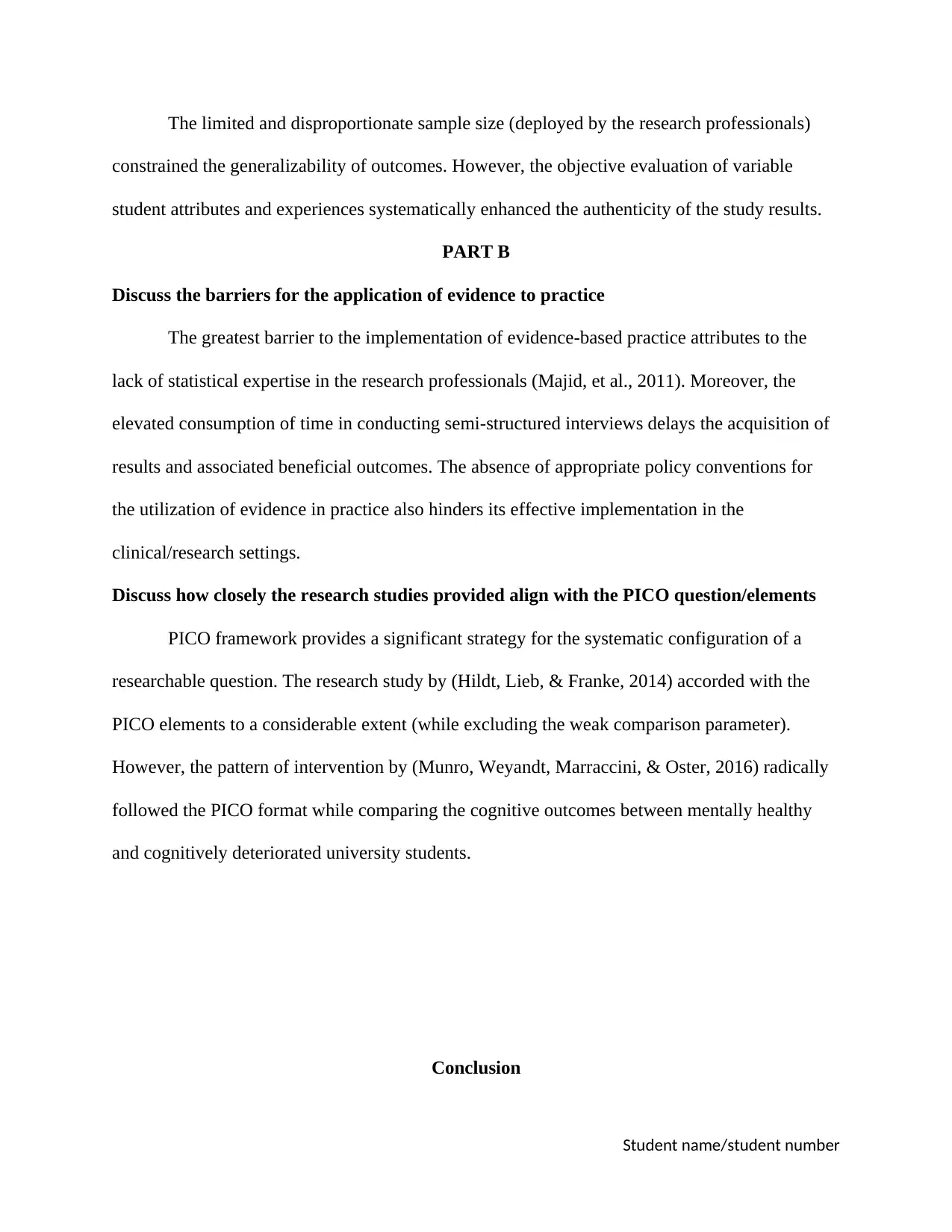
The limited and disproportionate sample size (deployed by the research professionals)
constrained the generalizability of outcomes. However, the objective evaluation of variable
student attributes and experiences systematically enhanced the authenticity of the study results.
PART B
Discuss the barriers for the application of evidence to practice
The greatest barrier to the implementation of evidence-based practice attributes to the
lack of statistical expertise in the research professionals (Majid, et al., 2011). Moreover, the
elevated consumption of time in conducting semi-structured interviews delays the acquisition of
results and associated beneficial outcomes. The absence of appropriate policy conventions for
the utilization of evidence in practice also hinders its effective implementation in the
clinical/research settings.
Discuss how closely the research studies provided align with the PICO question/elements
PICO framework provides a significant strategy for the systematic configuration of a
researchable question. The research study by (Hildt, Lieb, & Franke, 2014) accorded with the
PICO elements to a considerable extent (while excluding the weak comparison parameter).
However, the pattern of intervention by (Munro, Weyandt, Marraccini, & Oster, 2016) radically
followed the PICO format while comparing the cognitive outcomes between mentally healthy
and cognitively deteriorated university students.
Conclusion
Student name/student number
constrained the generalizability of outcomes. However, the objective evaluation of variable
student attributes and experiences systematically enhanced the authenticity of the study results.
PART B
Discuss the barriers for the application of evidence to practice
The greatest barrier to the implementation of evidence-based practice attributes to the
lack of statistical expertise in the research professionals (Majid, et al., 2011). Moreover, the
elevated consumption of time in conducting semi-structured interviews delays the acquisition of
results and associated beneficial outcomes. The absence of appropriate policy conventions for
the utilization of evidence in practice also hinders its effective implementation in the
clinical/research settings.
Discuss how closely the research studies provided align with the PICO question/elements
PICO framework provides a significant strategy for the systematic configuration of a
researchable question. The research study by (Hildt, Lieb, & Franke, 2014) accorded with the
PICO elements to a considerable extent (while excluding the weak comparison parameter).
However, the pattern of intervention by (Munro, Weyandt, Marraccini, & Oster, 2016) radically
followed the PICO format while comparing the cognitive outcomes between mentally healthy
and cognitively deteriorated university students.
Conclusion
Student name/student number
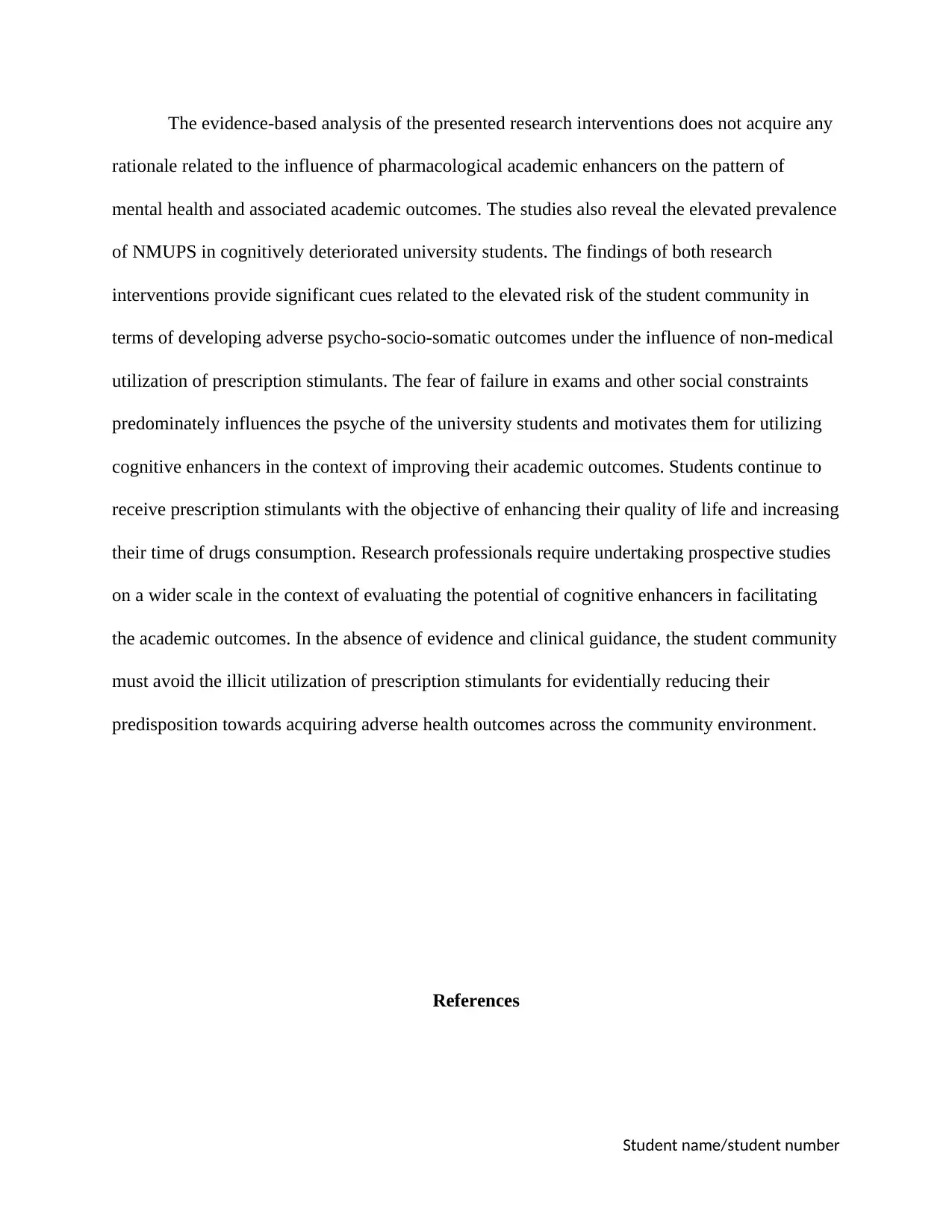
The evidence-based analysis of the presented research interventions does not acquire any
rationale related to the influence of pharmacological academic enhancers on the pattern of
mental health and associated academic outcomes. The studies also reveal the elevated prevalence
of NMUPS in cognitively deteriorated university students. The findings of both research
interventions provide significant cues related to the elevated risk of the student community in
terms of developing adverse psycho-socio-somatic outcomes under the influence of non-medical
utilization of prescription stimulants. The fear of failure in exams and other social constraints
predominately influences the psyche of the university students and motivates them for utilizing
cognitive enhancers in the context of improving their academic outcomes. Students continue to
receive prescription stimulants with the objective of enhancing their quality of life and increasing
their time of drugs consumption. Research professionals require undertaking prospective studies
on a wider scale in the context of evaluating the potential of cognitive enhancers in facilitating
the academic outcomes. In the absence of evidence and clinical guidance, the student community
must avoid the illicit utilization of prescription stimulants for evidentially reducing their
predisposition towards acquiring adverse health outcomes across the community environment.
References
Student name/student number
rationale related to the influence of pharmacological academic enhancers on the pattern of
mental health and associated academic outcomes. The studies also reveal the elevated prevalence
of NMUPS in cognitively deteriorated university students. The findings of both research
interventions provide significant cues related to the elevated risk of the student community in
terms of developing adverse psycho-socio-somatic outcomes under the influence of non-medical
utilization of prescription stimulants. The fear of failure in exams and other social constraints
predominately influences the psyche of the university students and motivates them for utilizing
cognitive enhancers in the context of improving their academic outcomes. Students continue to
receive prescription stimulants with the objective of enhancing their quality of life and increasing
their time of drugs consumption. Research professionals require undertaking prospective studies
on a wider scale in the context of evaluating the potential of cognitive enhancers in facilitating
the academic outcomes. In the absence of evidence and clinical guidance, the student community
must avoid the illicit utilization of prescription stimulants for evidentially reducing their
predisposition towards acquiring adverse health outcomes across the community environment.
References
Student name/student number
⊘ This is a preview!⊘
Do you want full access?
Subscribe today to unlock all pages.

Trusted by 1+ million students worldwide
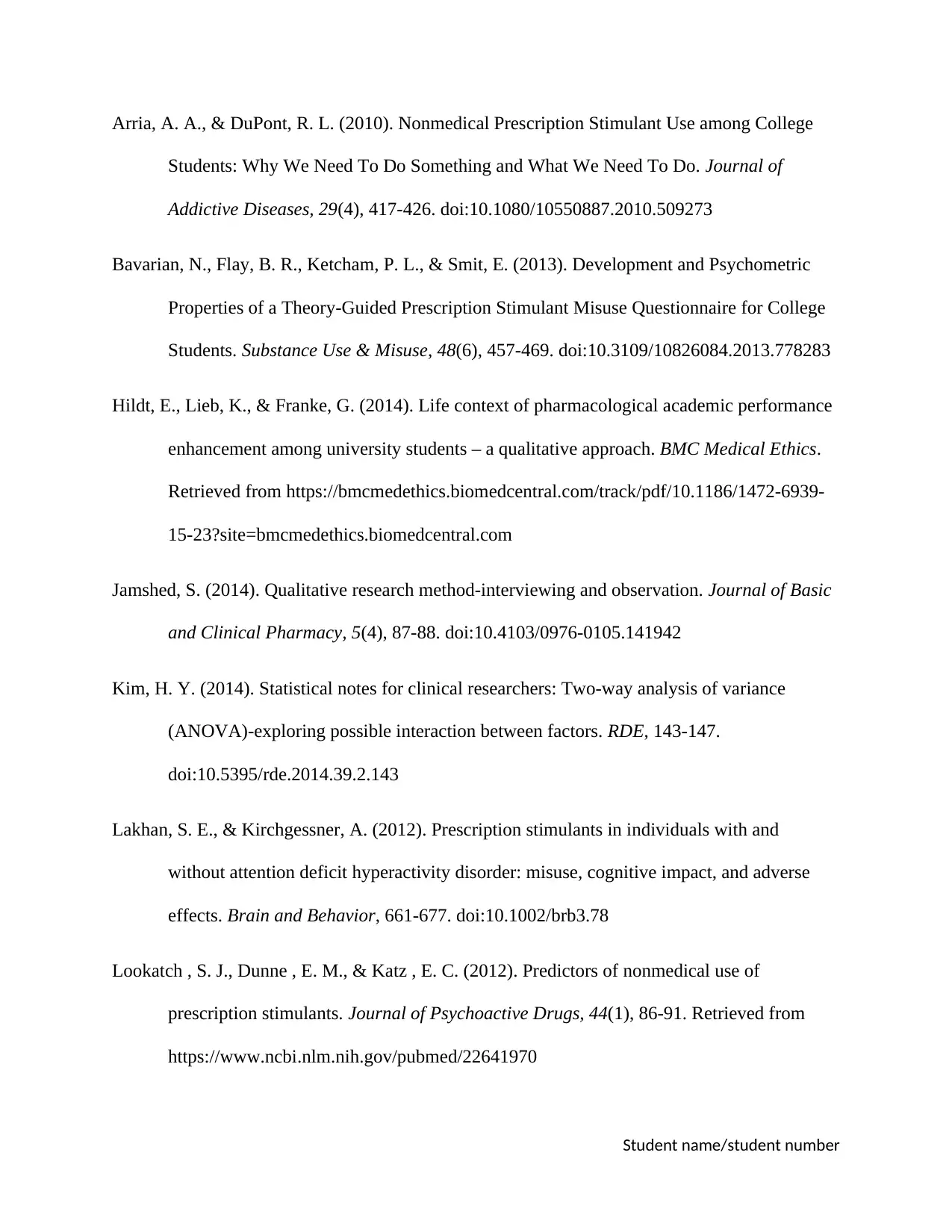
Arria, A. A., & DuPont, R. L. (2010). Nonmedical Prescription Stimulant Use among College
Students: Why We Need To Do Something and What We Need To Do. Journal of
Addictive Diseases, 29(4), 417-426. doi:10.1080/10550887.2010.509273
Bavarian, N., Flay, B. R., Ketcham, P. L., & Smit, E. (2013). Development and Psychometric
Properties of a Theory-Guided Prescription Stimulant Misuse Questionnaire for College
Students. Substance Use & Misuse, 48(6), 457-469. doi:10.3109/10826084.2013.778283
Hildt, E., Lieb, K., & Franke, G. (2014). Life context of pharmacological academic performance
enhancement among university students – a qualitative approach. BMC Medical Ethics.
Retrieved from https://bmcmedethics.biomedcentral.com/track/pdf/10.1186/1472-6939-
15-23?site=bmcmedethics.biomedcentral.com
Jamshed, S. (2014). Qualitative research method-interviewing and observation. Journal of Basic
and Clinical Pharmacy, 5(4), 87-88. doi:10.4103/0976-0105.141942
Kim, H. Y. (2014). Statistical notes for clinical researchers: Two-way analysis of variance
(ANOVA)-exploring possible interaction between factors. RDE, 143-147.
doi:10.5395/rde.2014.39.2.143
Lakhan, S. E., & Kirchgessner, A. (2012). Prescription stimulants in individuals with and
without attention deficit hyperactivity disorder: misuse, cognitive impact, and adverse
effects. Brain and Behavior, 661-677. doi:10.1002/brb3.78
Lookatch , S. J., Dunne , E. M., & Katz , E. C. (2012). Predictors of nonmedical use of
prescription stimulants. Journal of Psychoactive Drugs, 44(1), 86-91. Retrieved from
https://www.ncbi.nlm.nih.gov/pubmed/22641970
Student name/student number
Students: Why We Need To Do Something and What We Need To Do. Journal of
Addictive Diseases, 29(4), 417-426. doi:10.1080/10550887.2010.509273
Bavarian, N., Flay, B. R., Ketcham, P. L., & Smit, E. (2013). Development and Psychometric
Properties of a Theory-Guided Prescription Stimulant Misuse Questionnaire for College
Students. Substance Use & Misuse, 48(6), 457-469. doi:10.3109/10826084.2013.778283
Hildt, E., Lieb, K., & Franke, G. (2014). Life context of pharmacological academic performance
enhancement among university students – a qualitative approach. BMC Medical Ethics.
Retrieved from https://bmcmedethics.biomedcentral.com/track/pdf/10.1186/1472-6939-
15-23?site=bmcmedethics.biomedcentral.com
Jamshed, S. (2014). Qualitative research method-interviewing and observation. Journal of Basic
and Clinical Pharmacy, 5(4), 87-88. doi:10.4103/0976-0105.141942
Kim, H. Y. (2014). Statistical notes for clinical researchers: Two-way analysis of variance
(ANOVA)-exploring possible interaction between factors. RDE, 143-147.
doi:10.5395/rde.2014.39.2.143
Lakhan, S. E., & Kirchgessner, A. (2012). Prescription stimulants in individuals with and
without attention deficit hyperactivity disorder: misuse, cognitive impact, and adverse
effects. Brain and Behavior, 661-677. doi:10.1002/brb3.78
Lookatch , S. J., Dunne , E. M., & Katz , E. C. (2012). Predictors of nonmedical use of
prescription stimulants. Journal of Psychoactive Drugs, 44(1), 86-91. Retrieved from
https://www.ncbi.nlm.nih.gov/pubmed/22641970
Student name/student number
Paraphrase This Document
Need a fresh take? Get an instant paraphrase of this document with our AI Paraphraser
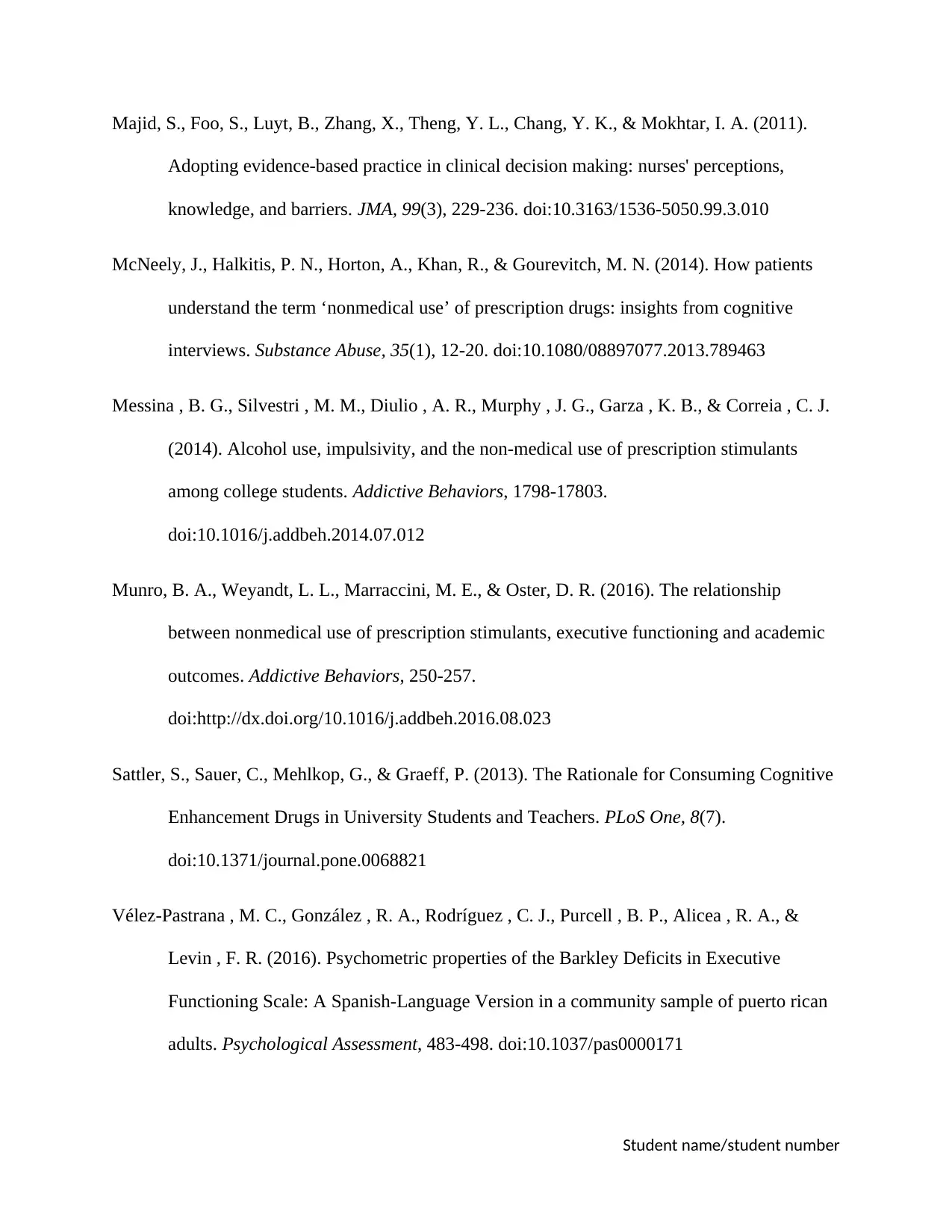
Majid, S., Foo, S., Luyt, B., Zhang, X., Theng, Y. L., Chang, Y. K., & Mokhtar, I. A. (2011).
Adopting evidence-based practice in clinical decision making: nurses' perceptions,
knowledge, and barriers. JMA, 99(3), 229-236. doi:10.3163/1536-5050.99.3.010
McNeely, J., Halkitis, P. N., Horton, A., Khan, R., & Gourevitch, M. N. (2014). How patients
understand the term ‘nonmedical use’ of prescription drugs: insights from cognitive
interviews. Substance Abuse, 35(1), 12-20. doi:10.1080/08897077.2013.789463
Messina , B. G., Silvestri , M. M., Diulio , A. R., Murphy , J. G., Garza , K. B., & Correia , C. J.
(2014). Alcohol use, impulsivity, and the non-medical use of prescription stimulants
among college students. Addictive Behaviors, 1798-17803.
doi:10.1016/j.addbeh.2014.07.012
Munro, B. A., Weyandt, L. L., Marraccini, M. E., & Oster, D. R. (2016). The relationship
between nonmedical use of prescription stimulants, executive functioning and academic
outcomes. Addictive Behaviors, 250-257.
doi:http://dx.doi.org/10.1016/j.addbeh.2016.08.023
Sattler, S., Sauer, C., Mehlkop, G., & Graeff, P. (2013). The Rationale for Consuming Cognitive
Enhancement Drugs in University Students and Teachers. PLoS One, 8(7).
doi:10.1371/journal.pone.0068821
Vélez-Pastrana , M. C., González , R. A., Rodríguez , C. J., Purcell , B. P., Alicea , R. A., &
Levin , F. R. (2016). Psychometric properties of the Barkley Deficits in Executive
Functioning Scale: A Spanish-Language Version in a community sample of puerto rican
adults. Psychological Assessment, 483-498. doi:10.1037/pas0000171
Student name/student number
Adopting evidence-based practice in clinical decision making: nurses' perceptions,
knowledge, and barriers. JMA, 99(3), 229-236. doi:10.3163/1536-5050.99.3.010
McNeely, J., Halkitis, P. N., Horton, A., Khan, R., & Gourevitch, M. N. (2014). How patients
understand the term ‘nonmedical use’ of prescription drugs: insights from cognitive
interviews. Substance Abuse, 35(1), 12-20. doi:10.1080/08897077.2013.789463
Messina , B. G., Silvestri , M. M., Diulio , A. R., Murphy , J. G., Garza , K. B., & Correia , C. J.
(2014). Alcohol use, impulsivity, and the non-medical use of prescription stimulants
among college students. Addictive Behaviors, 1798-17803.
doi:10.1016/j.addbeh.2014.07.012
Munro, B. A., Weyandt, L. L., Marraccini, M. E., & Oster, D. R. (2016). The relationship
between nonmedical use of prescription stimulants, executive functioning and academic
outcomes. Addictive Behaviors, 250-257.
doi:http://dx.doi.org/10.1016/j.addbeh.2016.08.023
Sattler, S., Sauer, C., Mehlkop, G., & Graeff, P. (2013). The Rationale for Consuming Cognitive
Enhancement Drugs in University Students and Teachers. PLoS One, 8(7).
doi:10.1371/journal.pone.0068821
Vélez-Pastrana , M. C., González , R. A., Rodríguez , C. J., Purcell , B. P., Alicea , R. A., &
Levin , F. R. (2016). Psychometric properties of the Barkley Deficits in Executive
Functioning Scale: A Spanish-Language Version in a community sample of puerto rican
adults. Psychological Assessment, 483-498. doi:10.1037/pas0000171
Student name/student number
1 out of 11
Related Documents
Your All-in-One AI-Powered Toolkit for Academic Success.
+13062052269
info@desklib.com
Available 24*7 on WhatsApp / Email
![[object Object]](/_next/static/media/star-bottom.7253800d.svg)
Unlock your academic potential
Copyright © 2020–2025 A2Z Services. All Rights Reserved. Developed and managed by ZUCOL.





